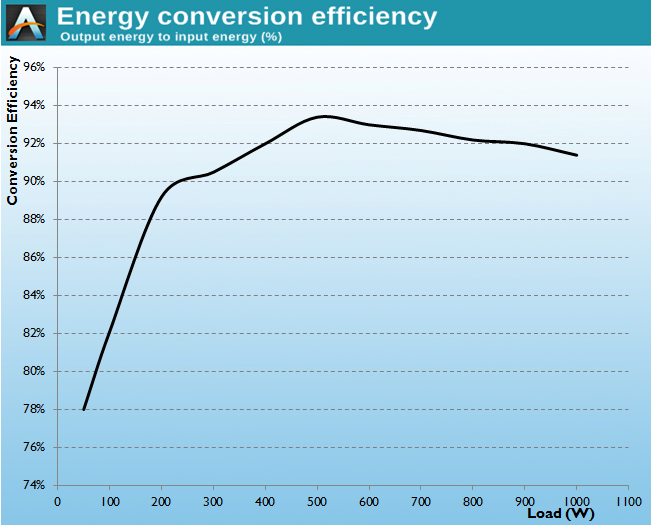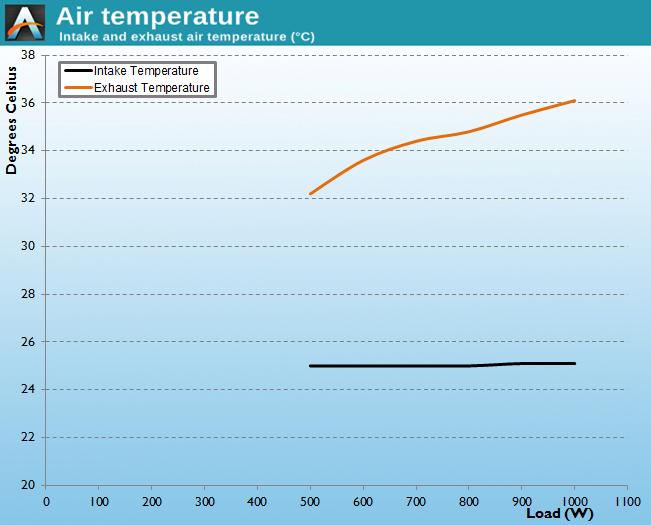Corsair RM1000 Power Supply Review
by E. Fylladitakis on April 24, 2014 6:00 AM EST- Posted in
- Cases/Cooling/PSUs
- Corsair
- PSUs
- RM Series
Cold Test Results
For the testing of PSUs, we are using high precision electronic loads with a maximum power draw of 2700W, a Rigol DS5042M 40MHz oscilloscope, an Extech 380803 power analyzer, two high precision UNI-T UT-325 digital thermometers, an Extech HD600 SPL meter, a self-designed hotbox, and various other bits and parts. For a thorough explanation of our testing methodology and more details on our equipment, please refer to our How We Test PSUs - 2014 article.
The Corsair RM1000 performs very well at room temperature, easily surpassing the 80Plus Gold Certification limits and reaching a maximum efficiency of 93.4% at 50% load. The average efficiency of the RM1000 within the nominal load range (20% to 100%) is 91.8%, which is an astonishing figure. When the load is reduced down to 50W, the efficiency drops down to 78%; however, although that may sound like a poor result, we should clarify that this actually is a very good figure and rarely can a PSU maintain an efficiency this high at just 5% load. However, such a low load is considered an "out of range" condition and does not affect the 80Plus certification, which takes into account only the 20% to 100% nominal capacity range.
There are no exhaust air temperature or noise measurements below 50% load because the fan does not spin until we reach 500W. The RM1000 is virtually inaudible while operating at room temperature, even when heavily stressed. Due to the passive cooling profile and the small heatsinks, however, the RM1000 tends to run warm, with the temperature of the tiny secondary side heatsinks floating around 55 °C and reaching up to 59.7 °C.















55 Comments
View All Comments
khanov - Saturday, April 26, 2014 - link
You can turn off the fanless mode on Seasonic's PSUs. That'd be a good option for Corsair to adopt I think.As for the Teapo comment, surely you cannot be serious. Teapo electrolytics as filters are a terrible option. They rarely last even half their rated lifetime. I replace Teapos quite a lot in consumer electronics devices (TVs, set top boxes, DVRs etc). They seem to go about 5 years on average before they fail with open vents.
The real problem when you go lower than first tier Japanese is that the manufacturers will sometimes straight up lie on their spec sheets. So they look like they should perform just as well on paper, but they never meet that performance in real applications unless treated much more gently than their specs would suggest. Ripple current (real vs rated) is one area where I see a lot of this happening and Teapo is one of the culprits.
YoloPascual - Friday, April 25, 2014 - link
I know your work for Corsair now jonny. Don't worry many ppl will still buy your incompetent psu because most of the people knows that if a psu has corsair sticker, it must be excellent.And no japanese caps are not over-rated actually they are under-rated. I got a Delta made psu from 1999 running like champ. It has a combination of Rubycons and Nippon-Chemicon.
royalcrown - Monday, April 28, 2014 - link
Come on! You act like Corsair sells dog poop. Whether or not you like them, they are not junk either. Calling it incompetent just reeks epeen elitism...just4U - Saturday, April 26, 2014 - link
What I really dislike about the RM line is they are very close in price to the HX series that was made by seasonic. (A company I trust) I expected these to be made by them.. but nope. Ticks me off.. I like Corsair branded Seasonics.. their the only ones I will buy, period. If Corsair is moving away from them.. then I am moving away from Corsair.Harald - Monday, May 5, 2014 - link
Actually, there was only ever one HX model made by Seasonic and that was the first revision of the HX650. I have the HX750 which is made by CWT, it's going on 4 and half years old and working like a charm.Harald - Monday, May 5, 2014 - link
(Sorry, forgot about the HX520 and 620)khanov - Friday, April 25, 2014 - link
+1 from me too.I'd have to skip this and go straight for an all Japanese-capped unit.
Also, are you sure there aren't any Ltec caps int here? I can't see well enough, but those green filters on the secondary side look suspiciously like the worst caps money can buy.
sor - Friday, April 25, 2014 - link
I didn't see the voltage being tested. usually there's a 2-3% efficiency gain at 220-240VJASTECH - Friday, April 25, 2014 - link
I have a 1050w modular, don't recall brand, I bought before my surgery then ressesitated, ICU then on O2 24/7. So its been a few years sense my purchase, anyways, out of the box hooked up not working. Tested it, seems a 5vdc not working. Quality PSU is DOA, so QC is still lacking.meacupla - Saturday, April 26, 2014 - link
YES to ribbon cables. More PSUs should come with this, as it is superior to braided sleeving and individual strands in terms of routing and bundling.NO to right angle SATA connectors! The cable lengths end up being wrong anyways and there is extreme strain on the cable where the pins bite into the wire. The cable just doesn't bend as smoothly as daisy-chained straight connectors.